Transportation Context
Morton Street Station is one of three commuter rail stops on the MBTA Fairmount Line between South Station and Readville. In the 1980s, the Fairmount Line was extensively restored and improved to serve as an alternate route for Amtrak and commuter trains during the reconstruction of the Southwest Corridor. The line continued to be utilized after completion of the Southwest Corridor, providing important additional peak-period capacity to support expanded commuter rail service.
The most important public transportation service along Morton Street is provided by bus Routes 21 and 26, both of which connect this area with the Forest Hills Orange Line and Ashmont Red Line stations during MBTA service hours. The average weekday boardings and alightings for these bus routes at Morton Street Station are provided in Table 1.3 Maps for Route 21 and Route 26 are provided in the Appendix.
Table 1
Average Weekday Boardings and
Alightings at Morton Street Station
Inbound |
Outbound |
|||
Bus Route |
On |
Off |
On |
Off |
21 |
90 |
34 |
23 |
119 |
26 |
5 |
18 |
15 |
15 |
The surrounding neighborhoods are primarily residential, and on a recent site visit many local residents were seen walking from side streets to the bus stops located along Morton Street. Near the station, Morton Street is lined with small businesses, but only a few blocks away its frontage is residential. All access to inbound commuter rail trains for motorized traffic is from an entrance on Morton Street, but the focus of this study is the safe use of Morton Street by nonmotorized users.
Intersection Safety
Identifying Problem Intersections
Records available to Boston Region MPO staff show that there have been a total of seven crashes involving bicyclists and pedestrian crashes over the last several years within a half mile of Morton Street Station (see Table 2). 4 These represent less than one-tenth of the total crashes within the half-mile radius, the vast majority of which are auto-only crashes. Figure 1 illustrates the locations of the bicycle and pedestrian crashes in proximity to the Morton Street Station.
Table 2
Intersections within One-Half Mile of Morton Street Station with
Pedestrian or Bicycle Crashes from 2005 to 2009
Intersection |
City/Town |
Vehicle Crashes |
Pedestrian Crashes |
Bicycle Crashes |
Total Crashes |
Morton Street/Fuller Street |
Boston |
2 |
1 |
0 |
3 |
Morton Street/Corbet Street/Selden Street/West Selden Street |
Boston |
11 |
1 |
1 |
13 |
Morton Street/Evans Street |
Boston |
34 |
2 |
0 |
36 |
Morton Street/Norfolk Street |
Boston |
44 |
1 |
1 |
46 |
These seven crashes took place at four intersections along Morton Street (see Figure 2). They served as the set of problem intersections upon which this study focused. Arranged in order from west to east, these four intersections are:
- Morton and Norfolk Streets – 46 crashes total, including one involving a pedestrian and one involving a bicycle
- Morton and Evans Streets – 34 crashes total, including two involving pedestrians
- Morton, Corbet, Selden and West Selden streets – 13 crashes total, including one involving a pedestrian and one involving a bicycle
- Morton and Fuller Streets – 3 crashes total, including one pedestrian fatality
Intersection Analysis
This section describes the existing conditions and recommended improvements for the four identified problem intersections. The description of existing conditions is based on a site visit conducted on Tuesday, August 14, 2012, between 7:30 and 10:00 AM. Morton Street is a busy arterial, but it did not exhibit any features that were overtly dangerous in the study area. However, numerous minor maintenance-like improvements are clearly warranted at and between the four intersections discussed here. Restoring the roadway to an overall improved condition can be assumed to make the road safer for both motorized and nonmotorized users, even with its current physical configuration.
The recommended improvements are short -term in nature and were devised in order to help alleviate the concerns and issues identified during the site visit. Short-term recommendations primarily consist of the installation of signs and pavement markings and the upgrading of pedestrian signals, which may be implemented within a short time frame with local resources.
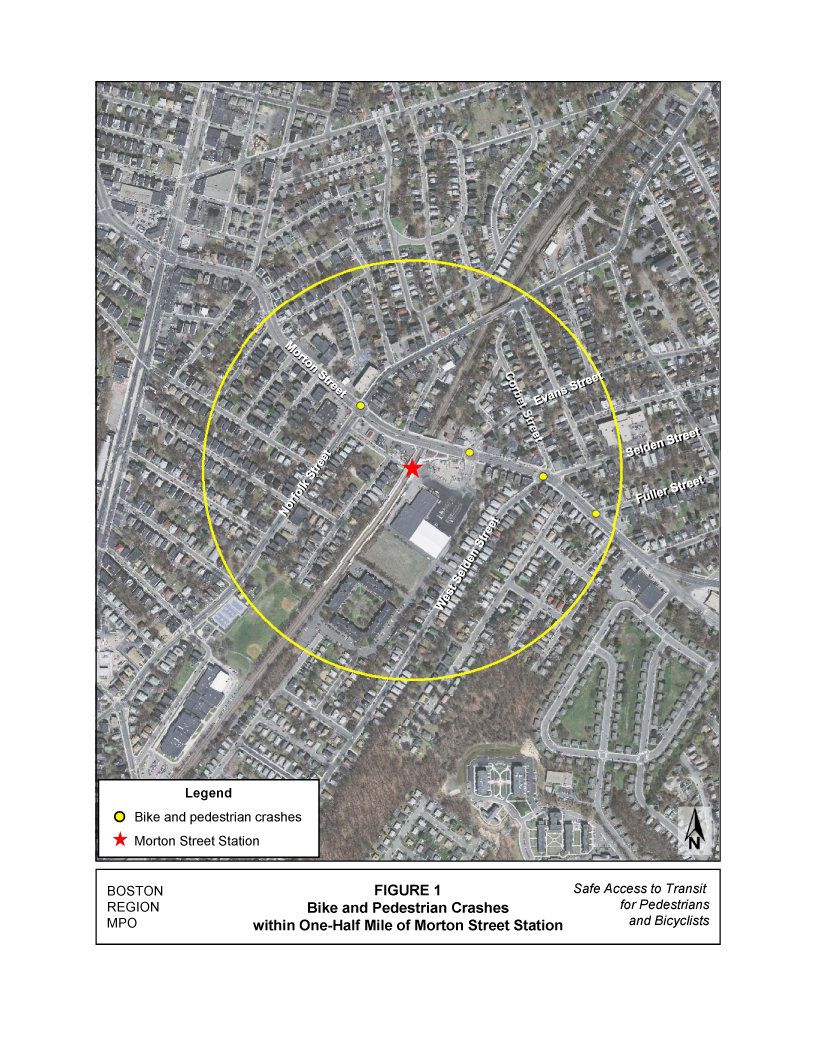

Morton and Norfolk Streets
Existing Conditions
There were 46 crashes, including one involving a pedestrian and one involving a bicyclist, at the intersection of Morton Street and Norfolk Street, which is located one block northwest of the Morton Street Station. Morton Street at Norfolk Street is the busiest intersection of the four discussed. During the AM peak hour, 690 vehicles approach from the west, 260 from the north, 400 from the south, and 1,125 from the east. There are a significant number of trucks, and 11.5% of the total approaching vehicles are making left turns.
Traffic on Morton Street has left-turn signals in both directions. Norfolk Street from the south has a right-turn signal that shows green during the Morton Street left-turn phase. Right-on-red turns are not permitted.
Norfolk Street has one wide lane in each direction, allowing right-turn storage at the intersection and on-street parking further away. Morton Street has two travel lanes in each direction. A fifth, left-turn lane and a narrow, granite rumble-strip center divider consume any spare pavement on Morton Street at this intersection. Parking is allowed on Morton Street west of Norfolk Street, but not to the east, which is the direction of the commuter rail station. There are no bicycle-specific features.
While traffic speeds appeared to be within the speed limit, traffic could be characterized as “hurried,” with jackrabbit starts and tailgating. Vehicles were observed passing the through-traffic queue on the rumble strip in order to reach the short left-turn lane. After the left-turn signal had turned red, some vehicles were observed turning left, apparently if the driver perceived what he or she considered a safe opportunity.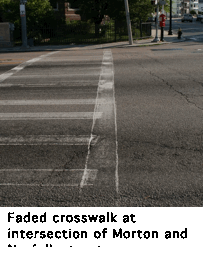 All legs of this intersection have ladder-style crosswalks, although they are faded. All of the sidewalks were in acceptable condition except on the northwest corner adjacent to the bus stop. The ramps were in acceptable physical condition. There were two on each corner, but only one had a detectable warning pad. There is a concern about the pedestrian signal buttons: on two corners there are large audible buttons, but on the other two corners there are old-style buttons. In addition, the audible buttons were not programmed to say “wait.” Pushing a button results in a dedicated pedestrian phase, but there is no countdown feature. The pedestrian signal timing is 20 seconds, which is sufficient for the lengths of crossings at this intersection.
All legs of this intersection have ladder-style crosswalks, although they are faded. All of the sidewalks were in acceptable condition except on the northwest corner adjacent to the bus stop. The ramps were in acceptable physical condition. There were two on each corner, but only one had a detectable warning pad. There is a concern about the pedestrian signal buttons: on two corners there are large audible buttons, but on the other two corners there are old-style buttons. In addition, the audible buttons were not programmed to say “wait.” Pushing a button results in a dedicated pedestrian phase, but there is no countdown feature. The pedestrian signal timing is 20 seconds, which is sufficient for the lengths of crossings at this intersection.
Recommended Improvements
The following short-term measures are recommended for improving safety for pedestrians and bicyclists:
- Upgrade pedestrian signals so that they are consistent at all corners of the intersection, including being fully accessible and having countdown features. A uniform set of equipment and protocols for all pedestrian signal equipment along Morton Street will help pedestrians acclimate to the safe and approved alternatives for crossing of this busy corridor.
- Restripe the existing crosswalks.
- Install ADA-compliant detectable warning pads on all pedestrian curb-cut ramps.
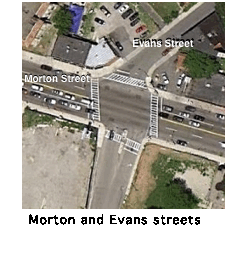 Stripe shared-lane markings (for bikes and motor vehicles) and install “Bicycles May Use Full Lane” (MUTCD R4-11) signs along Morton Street.
Stripe shared-lane markings (for bikes and motor vehicles) and install “Bicycles May Use Full Lane” (MUTCD R4-11) signs along Morton Street.
Morton and Evans Streets
Existing Conditions
There were 36 crashes, including two involving pedestrians, at the intersection of Morton Street and Evans Street, which is located northeast of the Morton Street Station. Immediately east of Norfolk Street, Morton Street becomes a bridge as it rises to cross the commuter rail line, and then descends to a signalized intersection with Evans Street as it approaches the bridge. Evans Street approaches Morton Street from the north and has two travel lanes in each direction. A wide commercial driveway approaches Morton Street from the south. The only traffic generator for the driveway at this time is a large plumbing and heating supplier, which could account for trucks and vans making up a large portion of the traffic. Accessible parking and a kiss-and-ride lane at the station will use this driveway when full two-track service resumes on the Fairmount Line. Also, there is a Dunkin’ Donuts under construction, as well as a small development parcel, that will utilize this driveway.
During the site visit, traffic was observed to be light on both Evans Street and the driveway. The driveway entrance is wide and has a short median, which is helpful for channeling trucks into and out of the driveway. There are no left-turn signals, and right-on-red is permitted throughout this intersection. There are no bicycle-specific features.
Traffic on Morton Street is heavy and clearly “hurried,” as observed during the site visit. Eastbound traffic appeared to possibly be exceeding the speed limit. Racing yellow lights and trying to beat on-coming traffic to make a left turn were observed to be commonplace.
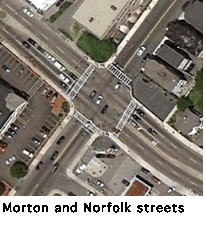 Sidewalks, ramps, and crosswalks are in
Sidewalks, ramps, and crosswalks are in
good condition, although one ramp has collected substantial debris. As at Norfolk Street, the pedestrian signals are problematic. Three corners have audible buttons, and one corner has an old-style button. The audible buttons tell when to walk, but are currently programmed for a quiet hum rather than the more intrusive chirp, despite having commercial uses on all four corners. Also, the pedestrian phase has been programmed to occur automatically every cycle, despite few pedestrians crossing. This loss of green time on Morton Street may exacerbate the practice of hurried driving. The pedestrian signal timing is 20 seconds, which is sufficient for the lengths of crossings at this intersection.
Recommended Improvements
The following short-term measures are recommended for improving safety for pedestrians and bicyclists:
- Ensure that sidewalks and roadways are well maintained and clear of debris and excessive dirt.
 Upgrade pedestrian signals so that they are consistent with the pedestrian signals at Morton and Norfolk streets; include fully accessible and countdown features. A uniform set of equipment and protocols for all pedestrian signal equipment along Morton Street would help pedestrians acclimate to the safe and approved alternatives for crossing of this busy corridor.
Upgrade pedestrian signals so that they are consistent with the pedestrian signals at Morton and Norfolk streets; include fully accessible and countdown features. A uniform set of equipment and protocols for all pedestrian signal equipment along Morton Street would help pedestrians acclimate to the safe and approved alternatives for crossing of this busy corridor.- Sign and stripe five-foot bike lanes in both directions along Morton Street, from Evans Street to Norfolk Street. Although shared-lane markings would be required for the majority of Morton Street due to right-of-way constraints, bike lanes would be valuable along this section of Morton Street because of the reduced visibility, since traffic rises and descends crossing the Fairmount Line tracks.
Morton, Corbet, Selden, and West Selden Streets
Existing Conditions
There were 13 crashes, including one involving a pedestrian and one involving a bicyclist, at the intersection of Morton Street with Corbet, Selden, and West Selden Streets, which is located approximately two blocks southeast of Morton Street Station. This is a five-way intersection, though traffic only approaches from four directions. West Selden Street is a two-way street that approaches Morton Street from the south. Selden and Corbet Streets are one-way streets north of Morton Street, directly opposite West Selden Street. Northbound traffic on West Selden Street can continue north onto the one-way Selden Street. Southbound traffic on Corbet Street can cross Morton Street and continue south on West Selden Street.
intersection of Morton Street with Corbet, Selden, and West Selden Streets, which is located approximately two blocks southeast of Morton Street Station. This is a five-way intersection, though traffic only approaches from four directions. West Selden Street is a two-way street that approaches Morton Street from the south. Selden and Corbet Streets are one-way streets north of Morton Street, directly opposite West Selden Street. Northbound traffic on West Selden Street can continue north onto the one-way Selden Street. Southbound traffic on Corbet Street can cross Morton Street and continue south on West Selden Street.
About 1,800 vehicles approach on Morton Street during the AM peak hour and about 9% turn onto the side streets, evenly split between left and right turns. Of the 265 vehicles approaching from the side streets, over 60% turn onto Morton Street. Frequent conflicts result from side street traffic making left turns, exacerbated by the occasional vehicle from Corbet Street making a hard left turn to Selden Street. There is significant truck traffic on Morton Street, but no trucks were observed on the side streets. Rights-on-reds are permitted and there are no specific bicycle features.
Morton Street has four travel lanes and on-street parking on both sides of the street. During the site visit, traffic appeared to be within the speed limit, but seemed hurried with both jackrabbit starts and tailgating observed.
Sidewalks, ramps, and crosswalks are in good condition. As is the case in the other two signalized intersection, the five corners provide a mix of audible and old-style crossing buttons. Pushing a button results in a dedicated pedestrian phase, but there is no countdown feature. The pedestrian signal timing is 21 seconds, which is sufficient for the lengths of crossings at this intersection.
Recommended Improvements
The following short-term recommendations would improve safety for pedestrians and bicyclists:
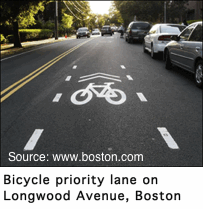
- Upgrade pedestrian signals so that they are consistent with the pedestrian signals at Morton and Norfolk streets, including with fully accessible and countdown features. A uniform set of equipment and protocols for all pedestrian signal equipment along Morton Street will help pedestrians acclimate to the safe and approved alternatives for crossing of this busy corridor.
- Stripe shared-lane markings (for bikes and motor vehicles) and install “Bicycles May Use Full Lane” (MUTCD R4-11) signs. The width of Morton Street to the west and east of this intersection, and the presence of on-street parking, suggests that shared-lane markings would be the appropriate method to indicate and encourage the use of Morton Street by bicycles. Given the size of the intersection, the shared-lane markings should continue through the intersection as bicycle priority lanes.
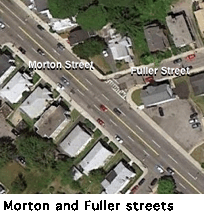 Morton and Fuller Streets
Morton and Fuller Streets
Existing Conditions
There were 3 crashes, including one with a pedestrian, at the intersection of Morton Street and Fuller Street, which is located approximately three blocks southeast of the Morton Street Station. Fuller Street is a one-way street that approaches Morton Street from the north, ending at a “T” intersection and a stop sign. The double yellow line in the middle of Morton Street has a gap, allowing lawful left turns. Only a handful of vehicles were seen using Fuller Street, all of which made right turns.
The heavy traffic on Morton Street at this location moves rapidly here at roughly the midpoint between two major intersections. While parking is permitted on Morton Street, few vehicles were parked in the vicinity, effectively widening the right travel lane and inviting higher speeds. Morton Street traffic included a number of trucks, and there are no specific bicycle facilities.
The sidewalks are wide and in good condition. The ramps are also in good condition, although the pavement adjacent to the concrete ramp on one corner has subsided more than an inch. There is a crosswalk painted across Fuller Street, but none across Morton Street.
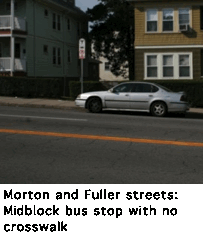 The most dangerous circumstance at this intersection is the presence of a pair of MBTA bus stops on each side of Morton Street at Owen Street, 140 feet east of Fuller Street and also lacking a marked crosswalk over Morton Street. While use of an unmarked crosswalk is permitted, this would be a less-safe option for crossing Morton Street, especially if pedestrians are rushing to catch an approaching bus. Pedestrian traffic in this area, transit related and otherwise, would probably not warrant the installation of a marked crosswalk.
The most dangerous circumstance at this intersection is the presence of a pair of MBTA bus stops on each side of Morton Street at Owen Street, 140 feet east of Fuller Street and also lacking a marked crosswalk over Morton Street. While use of an unmarked crosswalk is permitted, this would be a less-safe option for crossing Morton Street, especially if pedestrians are rushing to catch an approaching bus. Pedestrian traffic in this area, transit related and otherwise, would probably not warrant the installation of a marked crosswalk.
Recommended Improvements
The following short-term recommendations would improve safety for pedestrians and bicyclists:
- Stripe shared-lane markings (for bikes and motor vehicles) and install “Bicycles May Use Full Lane” (MUTCD R4-11) signs along Morton Street east of Selden Street. The presence of on-street parking that is not fully utilized is especially beneficial to cyclists. Shared-lane markings striped along the ample right lane in this section may calm traffic. The paucity of parked cars would also afford cyclists more room and allow them to focus their vigilance on a limited amount of parked cars and parking activity.
- Eliminate the existing bus stops at Owen Street and replace with new bus stops at the junction of Morton Street and Gallivan Boulevard.
- Bus stops are not currently practical at this location because of the requirement that eastbound buses merge left to continue their routes on Gallivan Boulevard. However, a recently completed Intersection Alternatives Design Report (MassDOT, June, 2012) proposes improved traffic channels and crosswalks at the junction of Morton Street and Gallivan Boulevard. Incorporating new MBTA bus stops into the final design is recommended as a high priority for both safety and user benefits.
- East of Selden Street, bus stops for routes 21 and 26 are spaced an average of 575 feet apart. Since buses cannot currently stop at the junction of Morton Street and Gallivan Boulevard, the closest stops are at the remote and problematic Owen Street to the west, and at Wilmington Avenue to the east. Replacing the Owen Street and Wilmington Avenue bus stops with one stop at the junction of Morton Street and Gallivan Boulevard will speed bus service through the net elimination of one stop, and add service at an important neighborhood nexus. With this modification, the average stop spacing would be 863 feet, and a preliminary analysis suggests that the maximum spacing would be about 955 feet, which falls within MBTA’s bus stop spacing guidelines.
Building on Safety: A New Access Vision
The recommendations provided in this study aim to promote accessibility to the Morton Street Station from surrounding neighborhoods for pedestrians and bicyclists. If implemented, these recommendations would provide pedestrians and bicyclists with safer and more convenient paths to Morton Street Station.
The recommendations are short-term, low-cost and quick to implement. Short-term improvements recommended in this study include restriping pavement markings and crosswalks, installation of ADA improvements, striping bike lanes and/or shared lane markings, and upgrading pedestrian signals. These types of improvements will improve visibility between pedestrians, bicyclists, and motorists, indicate where these users should travel within the right-of-way (ROW), and provide a safer and more convenient environment.
Pedestrian safety can be improved in this corridor by installing a full set of updated pedestrian signals where warranted along this corridor, and programming them in a consistent manner. Bicycle safety can be improved by adding shared lane markings throughout, except on the overpass over the Fairmount commuter rail line, where the prohibition of on-street parking makes a fully-marked bicycle lane desirable. Ensuring the pavement along the roadway adjacent to curbs is in good condition, without any potholes, bumps, or longitudinal drain grates and ensuring sidewalks and roadways are clear of debris and excessive dirt will also improve the bicycling environment along the Morton Street corridor.
Mid and long-term improvements for Morton Street, as proposed by MassDOT, would renew the physical condition of Morton Street, which would result in safer travel for all users, both motorized and nonmotorized. The proposed reconstruction of the intersection of Morton Street and Gallivan Boulevard would allow for the consolidation of the problematic Owen Street bus stop near Fuller Street to a safe location at a new signalized crosswalk. Another long-term improvement for Morton Street would be ensuring adequate lighting throughout the corridor.
It is possible to put the recommended Morton Street improvements into a broader context. The Fairmount Line is a major geographical barrier slicing Boston over much its north-south extent. In the future, the Fairmount Line will become an ever more important radial travel corridor.
Historical development patterns in response to the Fairmount Line have resulted in a limited number of major east-west streets crossing the radial rail line. The location and size of these east-west crossings are defined by the Fairmount Line and can be considered as fixed for the current planning horizons. The need for east-west travel in these neighborhoods is critical, and downgrading these few east-west corridors should not be considered feasible. All users, motorized and nonmotorized, will be sharing these east-west crossings in roughly their current configurations for the foreseeable future.
The four new stations being constructed on the Fairmount line will be located where the line meets each of the several major east-west roads that cross the line. One mile south of Morton Street, a station will be built at Cummins Highway, the major route from Mattapan to Roslindale. Less than a mile to the north a station will be built at Talbot Street, which connects Ashmont Station in south Dorchester with Franklin Park. The next station north of Talbot Street will be the “Four Corners” Station at Geneva Avenue, which connects the Fields Corner neighborhood with Roxbury. The fourth new station, Newmarket, will be located between Massachusetts Avenue and Southampton Street, both major thoroughfares.
The Morton Street analysis looks at the challenge of getting a very large number of users safely from one side of the Fairmount Line to the other, and simultaneously addresses the problem of safely accessing the commuter rail station. This analysis seeks to protect and encourage nonmotorized modes while acknowledging the vital vehicle corridor. The techniques and experience of improving safety on Morton Street should be applied to the other east-west arterials in the vicinity of where they meet the steadily improving Fairmount Line.
Implementing the recommendations in this study will improve the major roadway corridor used by pedestrians and bicyclists accessing Morton Street Station. This may encourage more users of Morton Street Station to choose bicycling and walking as modes of transportation, and may also promote the use of public transit. Overall, through the implementation of these recommendations, there will be improved access to safe, healthy, efficient, and varied transportation options.
MSA/WSK/wsk
APPENDIX
Maps of MBTA Bus Routes
Route 21 Map
Route 26 Map
General Recommendations
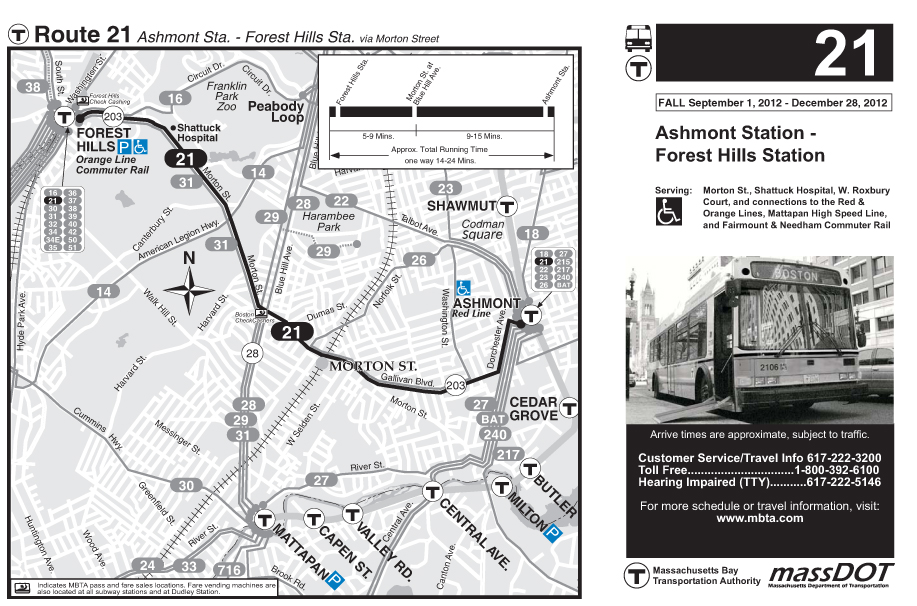
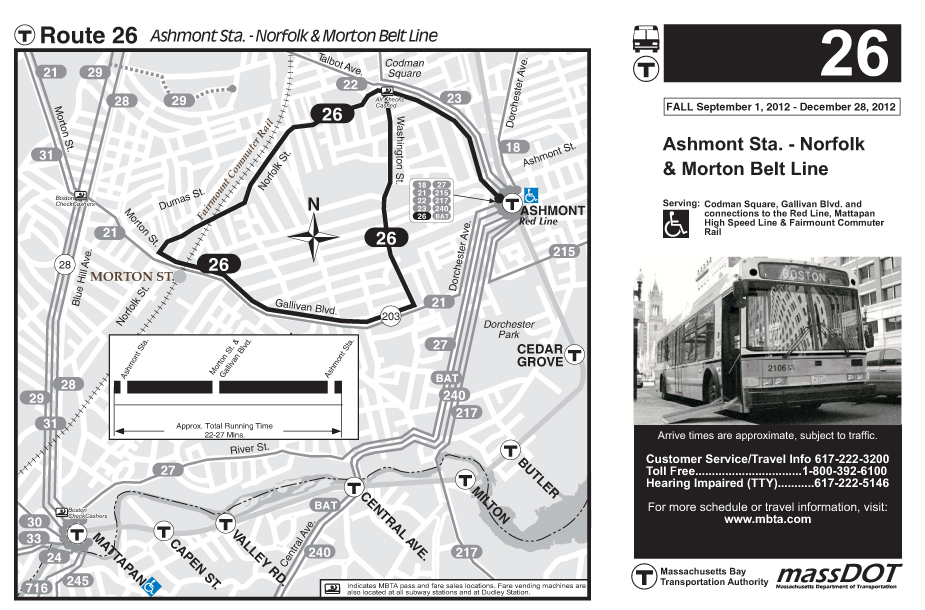
General Recommendations
Overall, none of the study locations have issues that seriously impede the access of pedestrians and bicyclists to a transit station. However, general maintenance issues should be addressed in all of the study areas. In addition, conditions and facilities could be further improved in order to enhance the safety and quality of pedestrian or bicyclist access; best-practices guidelines should be consulted and applied when possible.
Maintenance of Existing Facilities and Amenities
In each of the study areas, many of the existing facilities and amenities are in need of repair or upkeep. Faded crosswalk paint, uneven and broken pavement surfaces on sidewalks and roadways, malfunctioning pedestrian signals, and malfunctioning streetlamps are examples of facilities and amenities that are in need of attention. At a minimum, these should be in good, functional condition.
Seasonal Maintenance
Another condition commonly found at many study locations is a need for regular and seasonal upkeep of sidewalks and roadways. Dirt, sand, and debris accumulate in the gutters of roads and on sidewalks, particularly during and after the winter season. The winter also presents the issue of snow and ice, which are often piled onto sidewalks and along the sides of roads. In the summer, weeds and overgrown plants can obstruct pedestrian and bicyclist movement. Aside from being unpleasant and a nuisance, these conditions create obstructions that may make travel hazardous and impede transit patrons from easily using the MBTA system.
Sidewalks
It is important to provide a continuous and accessible network of sidewalks along walking routes to MBTA stations, particularly for pedestrians with disabilities. When a sidewalk is provided on only one side of a roadway, pedestrians often walk in the street or cross at unmarked midblock locations. Sidewalk surfaces should be level, smooth, and without obstructions in the pathway of pedestrians. In addition, best-practices guidelines recommend a buffer between the sidewalk and the roadway. However, on most of the streets in the study areas, roadway widths may not permit this feature.
In a few locations, the sidewalks do not have a curb-cut wheelchair ramp at crosswalks. Also at some locations, sidewalks have diagonal (apex) curb ramps, where only one ramp is provided at a street corner; these ramps typically are not aligned with the marked crosswalks. Diagonal curb ramps are the predominant type used in the study areas; however, this type of curb ramp is not recommended by current Federal Highway Administration best-practices guidelines. Instead, street corners should have two curb ramps, one aligned with one street’s crosswalk and the other aligned with the other street’s crosswalk (see the diagram at the left). For additional safety, the bottom of the ramps should have a detectable warming strip.
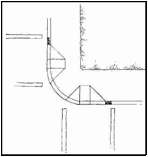 Crosswalks
Crosswalks
Source: www.fhwa.dot.gov
Best-practices guidelines recommend that crosswalks be well marked and accentuated by curb extensions. This study recommends, at a minimum, marking sidewalks with ladder-style striping. A 10-foot distance between the stop lines and crosswalks is recommended. Treatments for multilane roadways should include a 10-to-30-foot distance between the stop line and the crosswalk, pedestrian refuge islands/medians, and curb extensions for increased visibility of pedestrians. Also, this study recommends appropriate signs to warn motorists of pedestrian crossing activity.
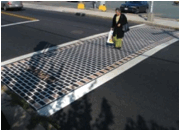
Source: streetprint.com
Signalized Pedestrian Crosswalks
 Some signalized pedestrian crossings in the study area have malfunctioning signals and buttons. As a first step, all existing signals should have functioning buttons and walk signals. Moreover, the crossings should be enhanced with more modern signal technology. For example, signals should be equipped with pedestrian activation buttons that light up when pushed, as an indication of having been successfully activated. Also, countdown-style pedestrian crossing signals (see photo, at left) should be used in places with a sufficient amount of pedestrian activity to warrant them.
Some signalized pedestrian crossings in the study area have malfunctioning signals and buttons. As a first step, all existing signals should have functioning buttons and walk signals. Moreover, the crossings should be enhanced with more modern signal technology. For example, signals should be equipped with pedestrian activation buttons that light up when pushed, as an indication of having been successfully activated. Also, countdown-style pedestrian crossing signals (see photo, at left) should be used in places with a sufficient amount of pedestrian activity to warrant them.
Intersection Safety
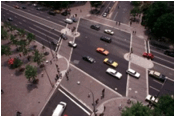 Several intersections in the study areas should be made safer for pedestrians and bicyclists through some minor redesign. (An example of a possibile redesign is shown in a photo below, from the website www.pedbikeimages.org/DanBurden.) Curb extensions at the corners, for instance, create a tighter turning radius for vehicles, which slows the speed of traffic at turns. Curb extensions also provide better sight lines for motorists to watch for pedestrians and vice versa. Furthermore, medians and islands can be enlarged to better guide and control traffic, often slowing vehicle speeds as well. Medians and traffic islands should be large and visible enough to provide sufficient refuge for pedestrians. Plus, striping should be clear and delineate the vehicle turning lanes, the crosswalks, and the stop lines. Lastly, intersections with significant pedestrian activity could be marked as a pedestrian crossing zone (instead of having only crosswalks), where an all-red pedestrian phase is part of the signal cycle.
Several intersections in the study areas should be made safer for pedestrians and bicyclists through some minor redesign. (An example of a possibile redesign is shown in a photo below, from the website www.pedbikeimages.org/DanBurden.) Curb extensions at the corners, for instance, create a tighter turning radius for vehicles, which slows the speed of traffic at turns. Curb extensions also provide better sight lines for motorists to watch for pedestrians and vice versa. Furthermore, medians and islands can be enlarged to better guide and control traffic, often slowing vehicle speeds as well. Medians and traffic islands should be large and visible enough to provide sufficient refuge for pedestrians. Plus, striping should be clear and delineate the vehicle turning lanes, the crosswalks, and the stop lines. Lastly, intersections with significant pedestrian activity could be marked as a pedestrian crossing zone (instead of having only crosswalks), where an all-red pedestrian phase is part of the signal cycle.
On-Street Bicycling
On many roads that lead to transit stations, bicyclists must contend with high traffic volumes and on-street parking. High traffic volumes, particularly when combined with high speeds and frequent turning movements, can be intimidating to bicyclists. Traffic-calming measures that reduce vehicle speeds can be implemented to help reduce both the severity and incidence of motor vehicle crashes with bicycles, and can also make bicyclists feel more comfortable while riding along roadways. On-street parking poses challenges in the form of conflicts between vehicles that are parking or discharging passengers, and bicyclists, who are often negotiating traffic to their left in addition to coping with the parked-vehicle activity to their right.
Roadway design and condition are also issues for bicyclists. Narrow lanes and narrow shoulders are a concern, particularly on roads with high traffic volumes. Potholes and poor pavement should be fixed, as bicyclists are more sensitive to pavement conditions than are motorists. Storm-sewer grates should be either grids or parallel bars appropriately placed perpendicular to traffic flow.
There are different types of on-street bicycle facilities that can be provided to improve safety for bicyclists, such as cycle tracks, buffered bike lanes, bike lanes, shared lanes, paved shoulders, and signed routes. Further study of the availability of right-of-way, roadway conditions and bicycle traffic volumes should be conducted in order to determine the type of on-street bicycle facility that would be appropriate for a specific roadway.
Bicycle Parking
All of the stations studied provide bicycle racks. When selecting locations for the installation of bicycle racks, it is important to consider visibility, lighting conditions, protection from the elements, and proximity to destinations. Additionally, racks should be situated in spots that offer enough space not only for storing bicycles, but also for maneuvering them. If bicycle racks or cages are located in an area not easily seen by bicyclists, then directional signage should be considered.
Current bicycle parking guidelines 5 recommend that providers of bicycle racks select types that:
- Support the bicycle upright by its frame in two places, enabling the frame and one or both wheels to be secured
- Allow both front-in and back-in parking
- Are compatible with today’s bike frames and with U-locks
 Common styles of bicycle parking racks that meet the above guidelines include: the inverted-U or hoop (see photo to left), “A” (a hoop with a horizontal bar), and post-and-loop (also known as bike hitch). Many manufacturers produce these or acceptable variations of these styles. These rack elements are typically arranged in a row or array; the spacing between the rack elements should be a minimum of 30 inches (on centers), but preferably a more comfortable 36 to 42 inches.
Common styles of bicycle parking racks that meet the above guidelines include: the inverted-U or hoop (see photo to left), “A” (a hoop with a horizontal bar), and post-and-loop (also known as bike hitch). Many manufacturers produce these or acceptable variations of these styles. These rack elements are typically arranged in a row or array; the spacing between the rack elements should be a minimum of 30 inches (on centers), but preferably a more comfortable 36 to 42 inches.
Signs: Wayfinding for Transit Stations
Well-placed wayfinding signs—pointing the way to a transit station—reach out to potential riders. They are similar in function to signs that direct motorists to highway ramps. Care should be taken to install the signs at a height and orientation favorable to pedestrians. Also, these signs should use conventional MBTA symbols, lettering, and colors.
Travel Environment
The aesthetic look and feel of the travel environment can encourage use by pedestrians and bicyclists. Communities should implement measures to improve the quality of the street environment through the use of landscaping (trees, shrubs, and flowers, all appropriately placed), lighting, furniture (such as benches and trashcans), and artwork (such as sculptures and murals). Chambers of commerce and business owners should also be encouraged to enhance storefronts and streetscapes.
Future Considerations
The opportunity to implement many of the recommended improvements may only arise when a roadway construction project occurs. Any roadway construction project should apply best-practices guidelines for serving pedestrian and bicyclist travel in general. More specifically, projects should improve walk and bike access to transit stops and stations as much as possible. In essence, the MBTA, the MassDOT Highway Division, local governments, and land developers should coordinate and cooperate on all transportation improvement projects to ensure that pedestrian and bicyclist needs are integrated into the final designs.
When improvements are made to the accessibility of transit for pedestrians and bicyclists, they can be highlighted in public information campaigns promoting the option of bicycling to transit stations. The improved accessibility can be extolled, along with the cost, time, and health benefits to individuals.
1 Boston Region Metropolitan Planning Organization, “Needs Assessment (Volume 2 of Paths to a Sustainable Region), produced by the Central Transportation Planning Staff, September 27, 2011.
2 Boston Region MPO, MBTA Systemwide Passenger Survey, CTPS, May 19, 2010.
3 MBTA Ridecheck Program; spring 2009 and winter 2010.